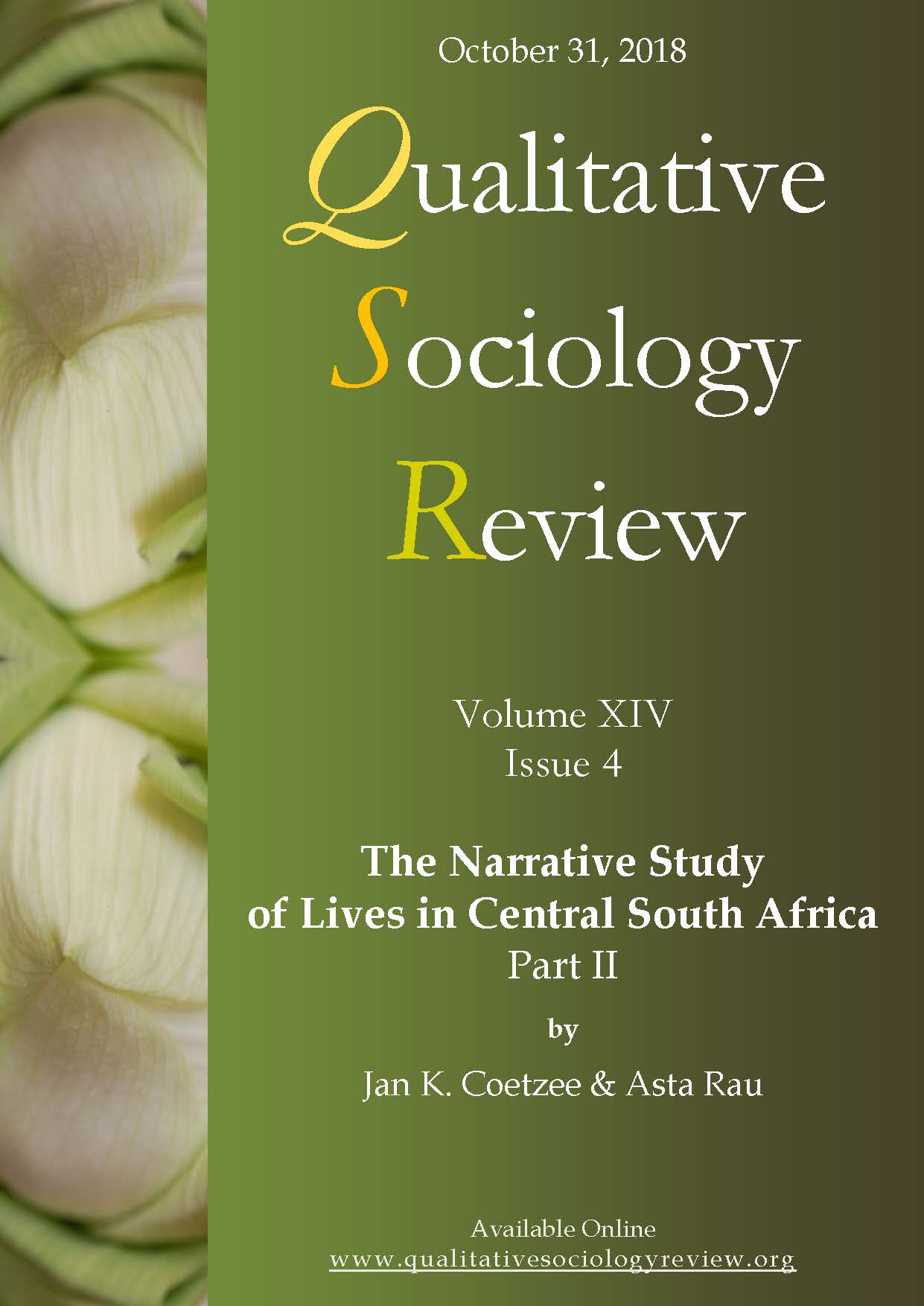Emotions and Belonging: Constructing Individual Experience and Organizational Functioning in the Context of an Orphans and Vulnerable Children (OVC) Program
DOI:
https://doi.org/10.18778/1733-8077.14.4.03Keywords:
Emotions, Belonging, Identity, Organizational Functioning, Orphans and Vulnerable Children (OVC), Sociological Imagination, Social ConstructivismAbstract
The analytical approach of this article is inspired by C. Wright Mills’ (1959) notion of “the sociological imagination.” Individual experience is viewed through the lens of the wider social context, particularly that of the organization. The socio-organizational context is then viewed through the lens of individual experience. The aim of this bi-directional gaze is to explore the relationship between individual experience and wider society. And in doing so, to identify and reveal the shared motifs—the significant, recurrent themes and patterns—that link and construct personal experience and social world. The aims, findings, and research processes of the original study are rooted in the instrumental epistemology of program evaluation. Specifically, a mixed-method implementation-evaluation of a local non-governmental organization’s Orphans and Vulnerable Children program. The aim of this article is to take the analyses and findings of that evaluation beyond its epistemic roots. Qualitative data were disentangled from the confines of thematic analysis and freed into their original narrative form. This allowed for a deeply reflexive “second reading,” which brings whole narratives into a dialogue with original findings, contextual factors, and sociological discourse. Key conceptual anchors are located in Vanessa May’s ideas on the self and belonging, and in Margaret Wetherell’s writings on affect and emotion. These are important aspects of working with children, particularly orphans and vulnerable children in South Africa, where many fall through the cracks of government’s social services. A second, deeper, qualitative reading of the narratives of children, their parents/caregivers, and the organization’s staff, explores three key pathways of individual and group experience that are inextricably linked to emotions and belonging, and which co-construct the social functioning of the organization itself.
Downloads
References
Berger, Peter L. and Thomas Luckmann. 1966. The Social Construction of Reality: A Treatise in the Sociology of Knowledge. New York: Doubleday.
Google Scholar
Birdsall, Karen and Kevin Kelly. 2007. Pioneers, Partners, Providers: The Dynamics of Civil Society and AIDS Funding in Southern Africa. Johannesburg: CADRE/OSISA.
Google Scholar
Bourdieu, Pierre and Loïc J. D. Wacquant. 1992. An Invitation to Reflexive Sociology. Cambridge: Polity Press & Blackwell.
Google Scholar
Burton, Patrick et al. 2016. The Optimus Study on Child Abuse, Violence and Neglect in South Africa. Cape Town: Centre for Justice and Crime Prevention & University of Cape Town (UCT).
Google Scholar
Carthy, Tal et al. 2010. “Emotional Reactivity and Cognitive Regulation in Anxious Children.” Behavior Research and Therapy 48(5):384-393.
Google Scholar
DOI: https://doi.org/10.1016/j.brat.2009.12.013
Chen, Huey-Tsyh. 2005. Practical Program Evaluation. Assessing and Improving Planning, Implementation, and Effectiveness. London: Sage.
Google Scholar
Coetzee, Jan K. and Asta Rau. 2009. “Narrating Trauma and Suffering: Towards Understanding Intersubjectively Constituted Memory.” Forum Qualitative Sozialforschung/Forum: Qualitative Social Research 10(2):Art. 14.
Google Scholar
DSD: Department of Social Development. 2005. Policy Framework on Orphans and Other Children Made Vulnerable by HIV and AIDS South Africa: Building a Caring Society Together. Pretoria: DSD.
Google Scholar
Feinstein, Clare and Claire O’Kane. 2005. The Spider Tool. A Self Assessment and Planning Tool for Child Led Initiatives and Organisations. Kathmandu: International Save the Children Alliance.
Google Scholar
Foucault, Michel. 1988. Politics, Philosophy, Culture: Interviews and Other Writings 1977-1984. New York: Routledge.
Google Scholar
Hall, Katharine, Helen Meintjes, and Winnie W. Sambu. 2015. “Demography of South Africa’s Children.” Pp 106-110 in South African Child Gauge, edited by Ariane De Lannoy et al. Cape Town: Children’s Institute, University of Cape Town.
Google Scholar
Jamieson, Lucy, Lizette Berry, and Lori Lake, (eds.). 2017. South African Child Gauge 2017. Cape Town: Children’s Institute, University of Cape Town.
Google Scholar
Kelly, Kevin and Karen Birdsall. 2010. “The Effects of National and International HIV/AIDS Funding and Governance Mechanisms on the Development of Civil-Society Responses to HIV/AIDS in East and Southern Africa.” AIDS Care 22 (Supplement 2):1580-1587.
Google Scholar
DOI: https://doi.org/10.1080/09540121.2010.524191
May, Vanessa. 2011. “Self, Belonging and Social Change.” Sociology 45(3):363-378.
Google Scholar
DOI: https://doi.org/10.1177/0038038511399624
Mills, C. Wright. 1959. The Sociological Imagination. Oxford: Oxford University Press.
Google Scholar
Pawson, Ray and Nick Tilley. 1997. Realistic Evaluation. London: Sage.
Google Scholar
Phillips, Denis C. 1990. Philosophy, Science and Social Inquiry: Contemporary Methodological Controversies in Social Science and Related Applied Fields of Research. Oxford: Pergamon Press.
Google Scholar
Rau, Asta, Florian Elliker, and Jan K. Coetzee. 2018. “Collecting Data for Analyzing Discourses.” Pp. 297-313 in The SAGE Handbook of Qualitative Data Collection, edited by Uwe Flick. London: Sage.
Google Scholar
DOI: https://doi.org/10.4135/9781526416070.n19
Rau, Asta et al. 2014. Evaluation of the Orphans and Vulnerable Children’s (OVC) Programme in Bloemfontein and Botshabelo (2012-2013). Bloemfontein: University of the Free State, Centre for Health Systems Research & Development (CHSR&D).
Google Scholar
Save The Children. 2005. Children in Focus: A Manual for Participatory Research with Children. Stockholm: Save the Children.
Google Scholar
Senge, Peter M. et al. 1994. The Fifth Discipline Fieldbook: Strategies and Tools for Building an Organization. New York: Doubleday.
Google Scholar
Sherr, Lorraine et al. 2016. “How Effective Is Help on the Doorstep? A Longitudinal Evaluation of Community-Based Organisation Support.” PLoS ONE 11(3). Retrieved September 02, 2018 (https://journals.plos.org/plosone/article?id=10.1371/journal.pone.0151305).
Google Scholar
DOI: https://doi.org/10.1371/journal.pone.0151305
Stats SA (Statistics South Africa). 2017. General Household Survey 2016. Pretoria: Stats SA.
Google Scholar
Turner, Jonathan H. 2009. “The Sociology of Emotions: Basic Theoretical Arguments.” Emotion Review 1(4):340-354.
Google Scholar
DOI: https://doi.org/10.1177/1754073909338305
Wetherell, Margaret. 2012. Affect and Emotion: A New Social Science Understanding. London: Sage.
Google Scholar
DOI: https://doi.org/10.4135/9781446250945
Wheatley, Margaret J. 1999. Leadership and the New Science. San Francisco: Berrett-Koehler.
Google Scholar
Wilcox, W. Bradford and Laurie DeRose. 2017. World Family Map 2017: Mapping Family Change and Child Well-Being Outcomes. New York, Barcelona: Social Trends Institute.
Google Scholar
Zuze, Tia Linda et al. 2016. Safe and Sound? Violence and South African Education. Pretoria: Human Sciences Research Council.
Google Scholar
Downloads
Published
How to Cite
Issue
Section
License
Copyright (c) 2018 Qualitative Sociology Review

This work is licensed under a Creative Commons Attribution-NonCommercial-NoDerivatives 4.0 International License.











